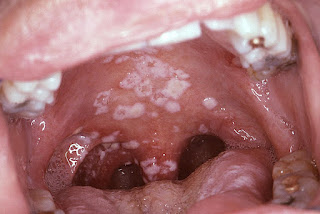Practice question answers oral cavity pathology
Practice question answers, oral cavity pathology Updated: 03/07/2019 © Jun Wang, MD, PhD 1. B. Polypoid growth with fibrous core and smooth non-neoplastic squamous covering is most compatible with irritation fibroma , a reactive process. Erythroplakia is usually a reddish patch/plaque that commonly harbors dysplasia. Pyogenic granuloma is indeed a capillary hemangioma with lobulated growth. Squamous cell carcinoma has irregular growth, invasion and cytological atypia. Squamous papilloma has finger like projects with fibrovascular core and benign squamous covering. 2. A. A small shallow oral erosion/ulcer without other presentations is most likely aphthous ulcer . Erythroplakia is usually a reddish patch/plaque that commonly harbors dysplasia. Hairy leukoplakia is a white patch/plaque with a smooth or “hairy” surface. Herpes has clusters of small painful vesicles. Squamous cell carcinoma has mass, with or without ulceration. 3. D. Herpes has clusters of small pai

